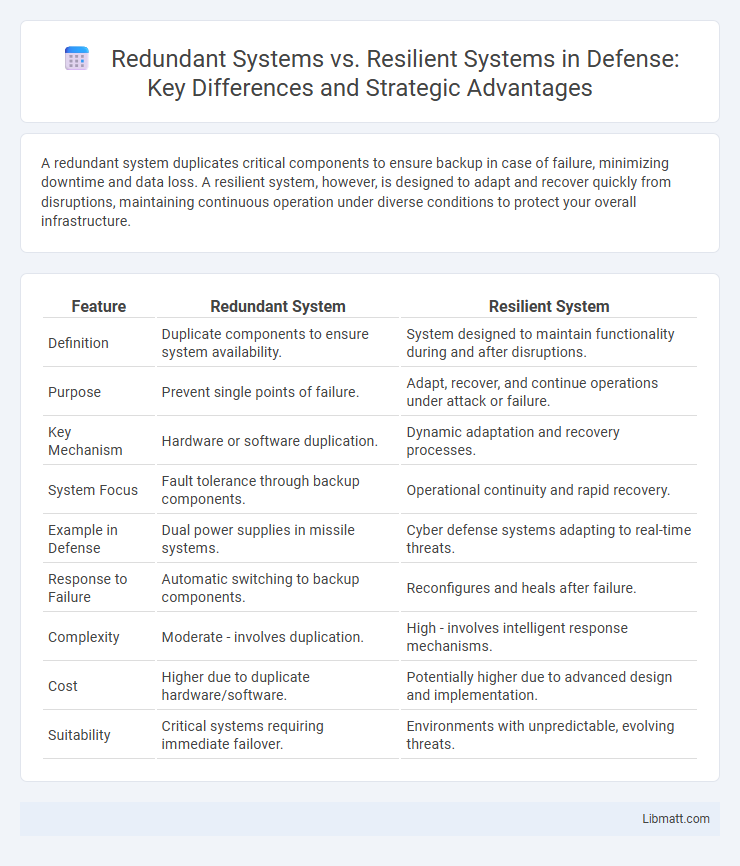A redundant system duplicates critical components to ensure backup in case of failure, minimizing downtime and data loss. A resilient system, however, is designed to adapt and recover quickly from disruptions, maintaining continuous operation under diverse conditions to protect your overall infrastructure.
Table of Comparison
| Feature | Redundant System | Resilient System |
|---|---|---|
| Definition | Duplicate components to ensure system availability. | System designed to maintain functionality during and after disruptions. |
| Purpose | Prevent single points of failure. | Adapt, recover, and continue operations under attack or failure. |
| Key Mechanism | Hardware or software duplication. | Dynamic adaptation and recovery processes. |
| System Focus | Fault tolerance through backup components. | Operational continuity and rapid recovery. |
| Example in Defense | Dual power supplies in missile systems. | Cyber defense systems adapting to real-time threats. |
| Response to Failure | Automatic switching to backup components. | Reconfigures and heals after failure. |
| Complexity | Moderate - involves duplication. | High - involves intelligent response mechanisms. |
| Cost | Higher due to duplicate hardware/software. | Potentially higher due to advanced design and implementation. |
| Suitability | Critical systems requiring immediate failover. | Environments with unpredictable, evolving threats. |
Introduction to Redundant and Resilient Systems
Redundant systems use duplicate components to ensure functionality during failures, minimizing downtime by switching to backup elements instantly. Resilient systems are designed to adapt, recover, and maintain operations despite unexpected disruptions or attacks, emphasizing flexibility and robustness. Your choice between redundant or resilient systems impacts overall reliability and operational continuity in critical environments.
Defining Redundancy in System Design
Redundancy in system design refers to the inclusion of extra components or subsystems that are not strictly necessary for normal operation but serve as backups to ensure continued function in case of failure. A redundant system duplicates critical parts or functions, allowing seamless switching to backup components to maintain uptime. Your system's reliability improves by minimizing single points of failure through strategic redundancy implementation.
Understanding System Resilience
A redundant system duplicates critical components to ensure continued operation during failures, while a resilient system adapts and recovers quickly from disruptions, maintaining functionality under stress. Your understanding of system resilience involves recognizing how resilience prioritizes flexibility and rapid recovery over merely having backup elements. This approach enhances long-term stability and performance in dynamic environments.
Key Differences Between Redundant and Resilient Systems
Redundant systems duplicate critical components to ensure continuous operation during failures, while resilient systems emphasize the ability to adapt, recover, and maintain functionality under adverse conditions. Redundancy concentrates on hardware or software backups, whereas resilience incorporates robustness, flexibility, and rapid recovery strategies. Your choice between redundant and resilient systems depends on priorities like minimizing downtime, cost-effectiveness, and long-term sustainability.
Advantages of Redundant Systems
Redundant systems enhance reliability by duplicating critical components, ensuring continuous operation even if one part fails, which minimizes downtime and maintenance costs. They provide immediate failover capabilities, improving system availability and reducing the risk of complete system failure. Your operations benefit from increased fault tolerance, allowing smoother performance under unexpected conditions.
Benefits of Resilient Systems
Resilient systems offer enhanced durability by adapting to and recovering from unexpected failures, ensuring continuous operation with minimal downtime. Unlike redundant systems that duplicate components, resilient systems leverage intelligent design and real-time monitoring to anticipate and mitigate risks effectively. Your infrastructure benefits from improved reliability, cost efficiency, and rapid response to disruptions, making resilient systems essential for modern, mission-critical applications.
Cost Factors: Redundancy vs Resilience
Redundant systems often incur higher upfront costs due to duplicated hardware and infrastructure, increasing capital expenditure and maintenance expenses. Resilient systems focus on adaptive strategies and robust design, potentially reducing long-term costs by minimizing downtime and optimizing resource use. Your choice between redundancy and resilience impacts both initial investment and operational efficiency, influencing total cost of ownership.
Common Use Cases for Redundant Systems
Redundant systems are commonly used in critical data centers, aerospace, and medical devices to ensure continuous operation during hardware failures by duplicating components such as power supplies, network interfaces, or storage devices. These systems are essential for environments where uptime and fault tolerance are paramount, minimizing downtime through immediate failover. Industries requiring high availability and disaster recovery solutions frequently implement redundant architectures to maintain service continuity and data integrity.
Real-World Applications of Resilient Systems
Resilient systems are widely applied in critical infrastructure such as power grids, healthcare networks, and financial services to ensure continuous operation during unforeseen disruptions. Unlike redundant systems that duplicate components for failover, resilient systems adapt dynamically to changing conditions, maintaining functionality even under stress. You benefit from resilient systems' ability to sustain performance and recover quickly from failures in complex, real-world environments.
Choosing the Right Approach: Redundancy or Resilience
Choosing between a redundant system and a resilient system depends on the specific reliability and availability requirements of the application. Redundant systems rely on duplicating critical components to prevent failure, ensuring immediate backup but potentially increasing complexity and cost. Resilient systems focus on adaptive recovery and fault tolerance, emphasizing robust design to maintain functionality during unexpected disruptions without full duplication.
Redundant system vs Resilient system Infographic

 libmatt.com
libmatt.com